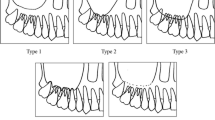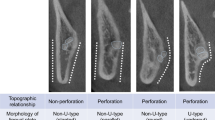Abstract
Purpose
In maxillary wisdom tooth extraction, the necessity of CT is unknown. The purpose of this study was to investigate whether CT adding to orthopantomography is useful for predicting oroantral perforation during maxillary third molar extraction.
Methods
Various risk factors for oroantral perforation during maxillary third molar extraction were investigated by univariate and multivariate analyses. We analyzed those of all patients and the patients who underwent CT, respectively. The proximity of the roots to the maxillary sinus floor (root-sinus [RS] classification) and Archer classification were assessed using panoramic radiography. The number of roots and vertical relationship were assessed using CT.
Results
A total of 604 out of 3299 patients underwent CT adding to orthopantomography. In all cases, multivariate analyses except for CT findings showed that the RS classification type III/IV and the Archer classification Type B/C/D in panoramic findings were significantly correlated with oroantral perforation as radiological findings. In cases for which CT was performed, multivariate analyses showed that one root (OR 12.87) and the vertical relationship Type D (OR 5.63) in CT findings, besides the RS classification type III/IV (OR 4.47) in panoramic findings, were significantly related to oroantral perforation.
Conclusion
The RS classification and the Archer classification in panoramic findings can predict the risk of oroantral perforation. The usefulness of CT adding to orthopantomography is limited. However, when the relationship between the upper wisdom tooth and maxillary sinus floor (RS classification) is unclear, to check whether the number of roots is one and the apex of one root is projecting into the maxillary sinus in CT findings, is useful for the prediction.





Similar content being viewed by others
References
Oberman M, Horowitz I, Ramon Y (1986) Accidental displacement of impacted maxillary third molars. Int J Oral Maxillofac Surg 15:756–758
Sverzut CE, Trivellato AE, Lopes LM, Ferraz EP, Sverzut AT (2005) Accidental displacement of impacted maxillary third molar: a case report. Braz Dent J 16:167–170
Bouquet A, Coudert JL, Bourgeois D, Mazoyer JF, Bossard D (2004) Contributions of reformatted computed tomography and panoramic radiography in the localization of third molars relative to the maxillary sinus. Oral Surg Oral Med Oral Pathol Oral Radiol Endod 983:342–347
Geiger SA, Eckert H (1975) Klinische und radiologische Untersuchungsergebnisse operierter Kieferh¨ohlen (clinical and radiological findings in the surgically treated maxillary sinus). Zahnarztl Prax 26:296–300
Schuchardt K, Pfeifer G, Lentrodt J (1964) Beobachtungen bei der Behandlung von F¨allen odontogener Kieferh¨ohlenentz¨undungen (observations on the treatment of cases of odontogenic maxillary sinusitis). Fortschr Kiefer Gesichtschir 9:130–137
Parvini P, Obreja K, Begic A, Schwarz F, Becker J, Sader R, Salti L (2019) Decision-making in closure of oroantral communication and fistula. Int J Implant Dent 5:13
Lim AA, Wong CW, Allen JC (2012) Maxillary third molar: patterns of impaction and their relation to oroantral perforation. J Oral Maxillofac Surg 70:1035–1039
Rothamel D, Wahl G, d'Hoedt B, Nentwig GH, Schwarz F, Becker J (2007) Incidence and predictive factors for perforation of the maxillary antrum in operations to remove upper wisdom teeth: prospective multicentre study. Br J Oral Maxillofac Surg 45:387–391
Hasegawa T, Tachibana A, Takeda D, Iwata E, Arimoto S, Sakakibara A, Akashi M, Komori T (2016) Risk factors associated with oroantral perforation during surgical removal of maxillary third molar teeth. Oral Maxillofac Surg 20:369–375
Archer HW (1975) Oral and maxillofacial surgery, 5th edn. WB Saunders, Philadelphia
Jung YH, Cho BH (2012) Assessment of the relationship between the maxillary molars and adjacent structures using cone beam computed tomography. Imaging Sci Dent 42:219–224
Lewusz K, Smektała T, Lesiakowski M, Butkiewicz F, Natora P, Sporniak-Tutak K (2015) Evaluation of risk factors for oroantral communication during the extraction of third upper molar. Dent Med Probl 52:17–21
del Rey-Santamaría M, Valmaseda Castellón E, BeriniAytés L, Gay EC (2006) Incidence of oral sinus communications in 389 upper third molar extraction. Med Oral Patol Oral Cir Bucal 11:334–338
Nedbalski TR, Laskin DM (2008) Use of panoramic radiography to predict possible maxillary sinus membrane perforation during dental extraction. Quintessence Int 39:661–664
Norman JE, Cannon PD (1967) Fracture of the maxillary tuberosity. Oral Surg Oral Med Oral Pathol 24:459–467
Shah N, Bridgman JB (2005) An extraction complicated by lateral and medial pterygoid tethering of a fractured maxillary tuberosity. Br Dent J 198:543–544
Cohen L (1960) Fractures of the maxillary tuberosity occurring during tooth extraction. Oral Surg Oral Med Oral Pathol 13:409–411
Demirtas O, Harorli A (2016) Evaluation of the maxillary third molar position and its relationship with the maxillary sinus: a CBCT study. Oral Radiol 32:173–179
Pourmand PP, Sigron GR, Mache B, Stadlinger B, Locher MC (2014) The most common complications after wisdom-tooth removal; part 2: a retrospective study of 1,562 cases in the maxilla. Swiss Dent J 124:1047–1061
Lewusz-Butkiewicz K, Kaczor K, Nowicka A (2018) Risk factors in oroantral communication while extracting the upper third molar: systematic review. Dent Med Probl 55:69–74
Jung YH, Cho BH (2015) Assessment of maxillary third molars with panoramic radiography and cone-beam computed tomography. Imaging Sci Dent 45:233–240
Masaki K, Makoto A, Shibata T, Omori K, Kato M, Nagayasu Y, Taira H, Murase H, Kaneko M (1995) Roentgenographic observations of upper wisdom teeth. Higashi Nippon Dent J 14:187–192 in Japanese
Acknowledgements
We received no external sources of funding for this study, either personally or institutionally. We thank Shinsuke Kuroki, Yujiro Hiraoka, Junpei Takeuchi, Akiko Yabase, and Junko Takahashi for their support and advice.
Author information
Authors and Affiliations
Contributions
Study design: E Iwata, T Hasegawa.
Acquisition of data: E Iwata E, M Kobayashi, N Takata, T Oko, D Takeda, Y Ishida, T Fujita, I Goto, J Takeuchi.
Analysis and interpretation of data: E Iwata, T Hasegawa, A Tachibana, M Akashi.
Manuscript preparation: E Iwata, T Hasegawa, M Kobayashi, A Tachibana, N Takata, T Oko, D Takeda, Y Ishida, T Fujita, I Goto, J Takeuchi, M Akashi.
Manuscript editing: E Iwata, T Hasegawa, M Akashi.
Manuscript review: E Iwata, T Hasegawa, M Kobayashi, A Tachibana, N Takata, T Oko, D Takeda, Y Ishida, T Fujita, I Goto, J Takeuchi, M Akashi.
Statistical analysis: E Iwata, T Hasegawa, A Tachibana, M Akashi.
Corresponding author
Ethics declarations
Informed consent was obtained from all individual participants included in the study. For patients aged <18 years, informed consent was sought from their parent/guardian. This retrospective study has been conducted in full accordance with the World Medical Association Declaration of Helsinki and was approved by the institutional review board of Kobe University Hospital (authorization number: 170020).
Additional information
Publisher’s note
Springer Nature remains neutral with regard to jurisdictional claims in published maps and institutional affiliations.
Rights and permissions
About this article
Cite this article
Iwata, E., Hasegawa, T., Kobayashi, M. et al. Can CT predict the development of oroantral fistula in patients undergoing maxillary third molar removal?. Oral Maxillofac Surg 25, 7–17 (2021). https://doi.org/10.1007/s10006-020-00878-z
Received:
Accepted:
Published:
Issue Date:
DOI: https://doi.org/10.1007/s10006-020-00878-z




